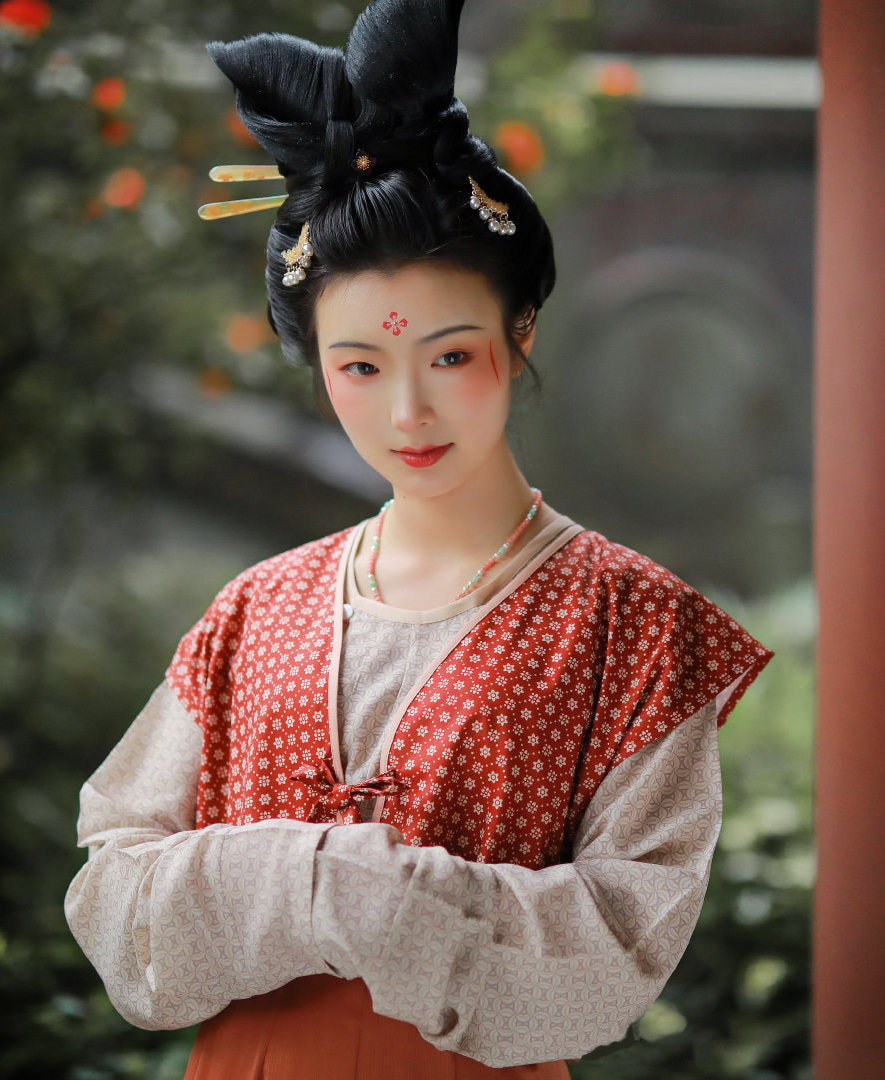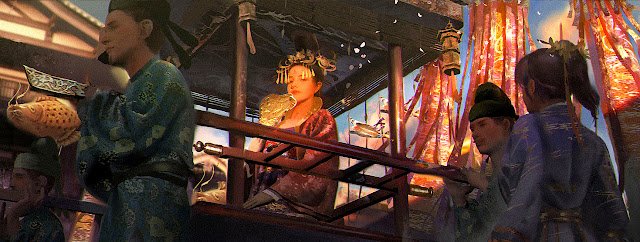Tang Dynasty Princess' Phoenix Crown 唐代李倕公主金凤冠
Phoenix Crown or "Feng Guan" 凤冠 of a Tang dynasty Princess: The bottom of the crown is a circle of pearls with ruby pendants as the fringe of the forehead. In the middle is a pair of peacock shaped flowers made of gold pieces, covered with small gold beads less than 0.015 cm. The sumptuous top layer is inlaid with turquoise, mother of pearls and other luxurious gems.
LONG FORGOTTEN UNDERNEATH
From 2001 to 2003, during the expansion of a new campus at the University of Technology in Xi'an, a large group of Tang dynasty tombs were discovered. There were 182 ancient tombs in total, including a princess of the Tang Dynasty. The centerpiece of that excavation was a Tang Dynasty gilded phoenix crown, inlaid with more than 370 precious stones of agate, pearl, amber, turquoise, amber, pearl, etc.

In her time, the princess' tomb was somewhat remote from the Tang capital, and it was also surrounded by civilian cemeteries. Since most of the cemetery that was excavated were no more than that of the commoners, at first, the archaeologists did not place too much expectation on this tomb.
A LONG LOST PRINCESS OF TANG
However, although the excavators entered the tomb without high expectations, they noticed murals painted on the walls of the tomb passage to the sarcophagus chamber after opening. Based on this, it is inferred that the tombs should belong to the nobles. However, the conditions of the painted murals were poor and cannot be fully identified, and some of them had already peeled off.
Li Zhui's tomb had been flooded for more than 1,200 years. During this period, it was flooded many times. The top of the tomb was severely damaged. The buried objects inside also drifted and floated. Later, it experienced an earthquake. The coffin was completely crushed. Fortunately, the ancient tomb has not been visited by tomb robbers, and the unearthed burial objects are very rich.
The skull of Princess Li Zhui. There were 370 broken pieces of a crown and its ornamental parts scattered all over the owner's skull, its condition was poorly preserved. The golden flowers, beads and other accessories fell from the phoenix crown.
When the dilapidated coffin of its occupant was opened, there was the skeleton of a woman with small glittering gilded pieces scattered about, after a moment of consideration, the archeologists slowly realized something momentous. This was a crown, a phoenix crown which were worn by privilidged women of the Tang imperial house. Despite their appearances in the records, this was the first time that China actually excavated an almost completely intact Tang dynasty phoenix crown.
The restored phoenix crown weighs more than 800 grams. The successful restoration of the exhibition caused a great sensation. The reasons are that there are only few Tang Dynasty crowns unearthed at present, and this is the first one that can be completely restored, the other is that the exquisite craftsmanship of the crown showed the refined capability of the Tang artisans.
EXTRACTION FROM THE SOIL
The excavators tried to clean up each individual item and scrub off the soot and water, but eventually stopped for fear of destroying the contour earth around the object. Realizing they could destroy this monumental find, they contacted higher experts. The archaeological team of the Shaanxi Provincial Institute of Archaeology was specially invited to extract the fragile phoenix crown with a plaster cast around both the skull and the crown itself.
The bottom of the crown is a circle of pearls with ruby pendants as the fringe of the forehead. In the middle is a pair of peacock shaped flowers made of gold pieces, covered with small gold beads less than 0.015 cm. The sumptuous top layer is inlaid with turquoise, mother of pearls and other luxurious gems.
The experts dug a hole around the phoenix crown, then insert the steel plate at the bottom, together with the floor tiles, translate the phoenix crown into a pre-prepared box, fill it with plaster on the spot, and move the whole scoop within the plaster tub to laboratory to carry out "indoor micro-excavation". After 3 years of reassembly and X ray testing by a combined team of Chinese and German experts, the Princess's crown was restored and its form reimposed over a mesh and displayed to the public.
Music: Calm of Heaven and Earth
THE PRINCESS HERSELF
Who is Princess Li Zhui 李倕? According to the epitaph, it can be seen that she was related to a founding ancestor of the Tang Dynasty, and she was a fifth generation descendant of the founding Tang Emperor Gaozu: Li Yuan, and her father, grandfather, and great-grandfather are all dukes of the Tang Dynasty. She was found to be about 1.6 meters tall, had a broad nose and round face.
She was married to a low level (七品) Tang official of Xianbei descent named Hòu Mòchén 候莫陈- the position was more akin to a university professor today. At the time. The two of them were considered to be a good match, with unusual affection for each other considering the nature of political marriages.

At the time they lived in the Shengyefang district, located to the east of the imperial city and to the west of Xingqing Palace where Emperor Xuanzong handled government affairs. It was a residence exclusively reserved for the nobles.
When she was 25 years old, Li Zhui gave birth to a baby boy. However, around the time her son was born, Li Zhui became ill and died of illness in her mansion on the 7th day of the first month in the 24th year of Kaiyuan (736.) It was speculated that she might have prematurely died due to dystocia.
A HEARTBREAKING EPITAPH
Her husband Hou Mochen was devastated. In Li Zhui's tomb there was an epitaph personally written for her: He described her as a punctual and polite woman, full of nobility becoming of her lineage, then end with the date of her death and the sad arrangement for her funeral, including a very personal ending.
有子在于襁褓,
终痛弥天之别。
旷野兮生荒草,
千秋万岁兮多悲风。
"The baby wrapped in swaddling,
the sight is agonizing,
The wilderness is full of weeds,
and the long future's full of sorrow."
The loss of his beloved wife, looking at the infant child, his heartache is as stinging as a knife cut. Through these words in the tomb, strangely we are left with the enduring pain of a man who loved her and misses her as he began to wade into a world without her. Such a strange thing that words does with time. That upon hearing of the speaker's plight we are placed- even for a moment as him. Let us hope that Hou and his new born son (ever new born to the listener) managed to scrap something wholesome in their own ever- approaching everafter.
Thank you to my Patrons who has contributed $10 and above: You made this happen!
➢ ☯ MK Celahir
➢ ☯ Muramasa
➢ ☯ Thomas Vieira
➢ ☯ Kevin
➢ ☯ Vincent Ho (FerrumFlos1st)
➢ ☯ BurenErdene Altankhuyag
➢ ☯ Stephen D Rynerson
➢ ☯ Michael Lam
➢ ☯ Peter Hellman
➢ ☯ SunB



























Comments
https://youtube.com/channel/UCE1PbqBaP2ye1MxfRH12jxg
I will take a break of this period for now and maybe go back and cover it.